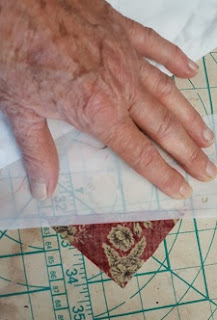Every quilter wants her quilt to be hers alone.
After all, she did the work, in spite of using classic shapes
and patterns, and manufactured fabrics.
How far will we go to make something unique?
One award winning quilt at Spring Paducah 2017 uses tiny pixel-like dots -
not fabric prints but "separate, minuscule dots"
placed with tweezers and fused.
not fabric prints but "separate, minuscule dots"
placed with tweezers and fused.
Others color their fabric, or use dye methods that produce random results.
Fussy cutting implies and requires selective choices.
It happens when we use the cut and position of the print
to create a focused design.
to create a focused design.
Joining two fussy cuts to create another image takes the concept further.
Paula Nadelstern has turned it into an art form,
and while I have never made a Nadelstern style kaleidoscope quilt,
her books taught me a lot over the years.
and while I have never made a Nadelstern style kaleidoscope quilt,
her books taught me a lot over the years.
Most are familiar with Willyne Hammerstein's Millifiori which uses
repetition of fussy cut English paper Piecing to create
amazing one-of-a -kind quilts.
amazing one-of-a -kind quilts.
In that method, the paper shape is covered with the fabric.
It's a simple matter of placement.
Juxtaposing Two Fussy Cuts,
My Process
- I start with a vague idea, then select a pattern and fabric that generally fits the idea.
- My work surface is an inexpensive cork board that measures about 17" X 23."
The Pattern
- I draw the pattern full size on graph paper from a tablet by June Tailor, 12.5" X 12.5." In this case I want my block to finish at 8" square. I use pencil in case I want to make changes. Note: Ziploc 2 gallon freezer bags are excellent pattern protectors at 13" X 15."
- I cut a piece of clear cellophane gift wrap the size of my pattern, and glue it over my pencil drawing with Elmer's Washable Glue Stick, to protect the paper pattern from glue from the fabric.
- The pattern is pinned to the cork board.(I love being able to pin into my work surface.)
- The center square is just a square-on-point, so I measure my pattern and make a "viewing window" from cardstock, the finished size of the square. I only need one, so I don't bother with a template.
Corner Triangle Template
- Using heat resistant template film (from Jinny Beyer Studio, sold as Multi-Purpose Template Film) I trace my corner piece. After adding 1/4" seam allowance to all edges I cut it out.
- A 1/16" hole punch, (from Jinny Beyer) puts a hole in the template at each seam intersection.
- With the template on the fabric, I trace guidelines from the fabric to be able to repeat the fussy cut. I believe I first learned this from Paula Nadelstern.
 |
| The Pattern and corner template |
The Fabric
- I will use pins to note the general edges of my center square, [note: see June 10, 2017 post] and remove the viewing window. Adding 3/8" seam allowance to the area for the center square, I cut the fabric, place it on the pattern and pin. The large seam allowance lets me re-arrange the square once the corner triangles are pinned to the board.

On the left, fabric for the center square. To the right is the fabric for the corner triangles. The corner triangles are cut using the template.
- I place the template on the fabric, lining up the guides on the template to the print in the fabric, and trace around template shape with a Micron Pen. With all four corners traced on the fabric, I cut them out.
 | |||||||
| Corner Triangle |
Using template film with a quarter inch guide marked, I starch, turn
and press the seam allowance along the long edge of the triangle.
Putting it together for glue basting...
- The center square is on the pattern and secured with 2 pins. Only one pin would allow it to "swivel."
- The corner triangles are pinned to the board, with the edges even with the corner pattern line PLUS one square or row, for the quarter inch seam allowance.
- The pieces are pinned only to the board, not to each other.
- With the corner triangles pinned in place, you can remove the pins in the center square and move it around slightly until you are happy with this 'trial run.' Pin the center in place again with 2 pins.
- Remove the triangles.
 |
| Putting glue on the seam allowance. Any glue that gets on the cellophane wipes up with a damp towel. |
- Thinking of the corners in terms of compass points, add glue to the seam allowance only of 2 of the triangles and place them at the North and South corners, exactly as in the 'trial run.'
- After the glue has set, but not dried, you can fold the triangles to the center, to reveal the seam allowance. Remove all the pins and carefully pull the unit loose. Take it to the machine and stitch in the crease that was pressed in when you turned the seam allowance.
- Press the triangles back in place, face up. Repeat the process with the East and West corners.
The center is finished!





No comments:
Post a Comment